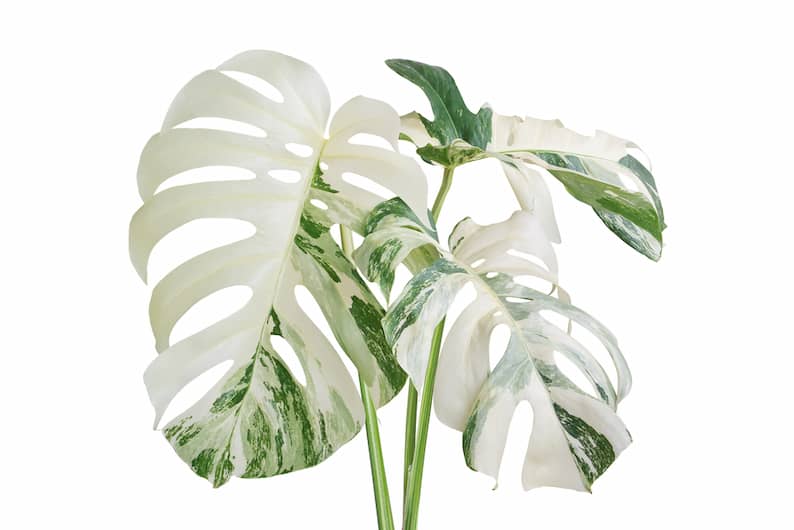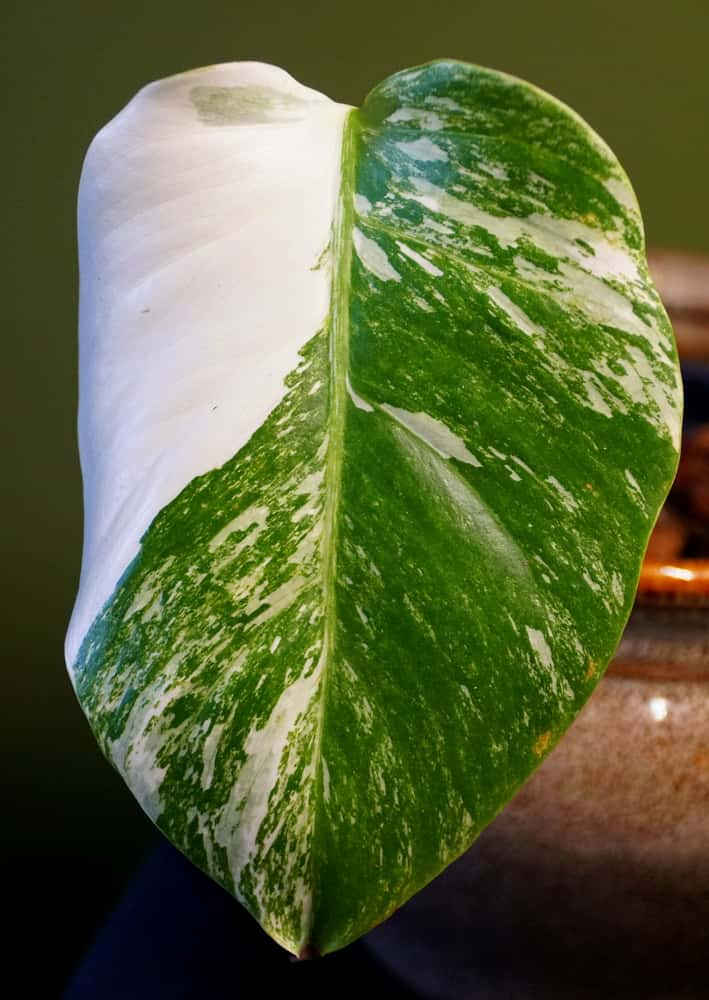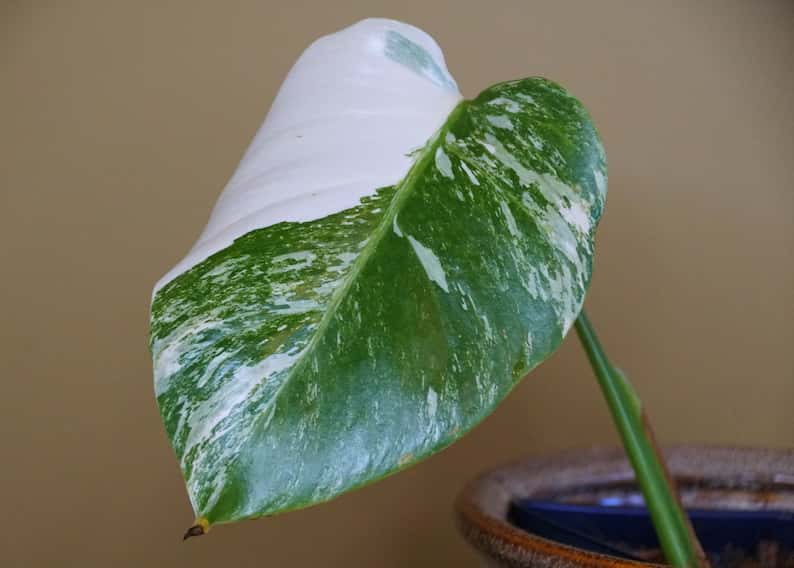Monstera are known for their beauty and ease of care, making them popular among houseplant collectors the world over. But for the real aficionados, there are a few cultivars that take the cake: chief among them being the awe-inspiring and elusive albino Monstera varieties.
The name is, in fact, a little deceiving. “Albino Monstera” or sometimes even “white Monstera” refers to Monstera variegata – anomalies of the plant world that present with white, cream, or yellow spots, speckles, or stripes set against dark green leaves. These plants are as rare as they are breath-taking, making them a must-have for serious collectors.
So, how common are these gorgeous species, and why are they the way they are? In this article, we’ll take a deep dive into everything there is to know about albino Monstera, from their genetic make-up to how to keep them thriving. Ready? Let’s investigate.

Table of Contents
What is a white Monstera called?
A white Monstera is typically referred to as Monstera albo variegata. “Albo” (which means white) refers to plant albinism, which accounts for the light-colored patches present on these rare species’ leaves. Variegata refers to “variegation,” which is the term we use for different colors of foliage.
When we hear the term “white Monstera,” it’s easy to conjure up the image of a fully white, jungle-esque beauty residing in our living rooms. While this isn’t entirely the case, the reality is not far off. A white Monstera is a rare specimen that has partial plant albinism, resulting in leaves with white speckles, spots, or patches.
Indeed, “white Monstera” is quite an all-encompassing term, covering multiple species within the Monstera genus itself. Plant albinism, which is a genetic mutation affecting plant tissue, can affect a range of different Monstera, from the deliciosa to the adansonii and many in between.
The variegation that occurs on white Monstera can also differ drastically from plant to plant. On some species, like the Monstera Thai Constellation, variegation takes the form of a spattering of creamy speckles. The half moon Monstera, on the other hand, can have bright white variegation covering basically entire halves of its leaves.
Unfortunately, a completely white Monstera would not survive past its seedling phase, as it would be unable to photosynthesize and grow. In the next section, we’ll unpack what exactly causes Monstera albinism toward a better understanding of this rare and beautiful mutation.
How do you get an albino Monstera?
Albinism is almost always the result of a genetic tissue mutation that prevents certain parts of a Monstera’s leaves and stems from producing chlorophyll. Chlorophyll cells are the components in plant tissue that give it its green color, so without them, leaves are left with light or white areas.
White Monstera are stunning freaks of nature that crop up only when they feel like it. Granted, the Monstera Thai Constellation, with its creamy speckles, has been bred from tissue culture in a lab, but that particular cultivar is the exception. For the most part, variegation in Monstera usually occurs at random.

This makes it difficult to definitively answer the question of how one gets an albino Monstera. The natural processes they undergo to mutate their cells are well-nigh impossible to replicate, so it’s a case of finding one on the market or trying to grow a Monstera via propagation from a stem cutting. Or, ultimately, waiting an eternity to see if one sporadically appears in your collection.
Given their lack of chlorophyll, variegated Monstera are also trickier to care for than their fully green cousins. These Monstera require more light to make up for their chlorophyll deficit, but not so much that they become burnt or scorched. The knock-on effect of this is that they are not as easy to propagate as regular Monstera.
And if that didn’t make them fussy enough, there is also the added bonus of the fact that they can return to plain green at any given point. A Monstera that has variegated areas is not guaranteed to retain them, especially if it doesn’t see enough sunlight.
Why are some Monstera white?
The natural occurrence of albino Monstera is purely the luck of the draw. As mentioned, one cultivar has been consistently bred in Thailand from tissue culture, but they are not considered true albinos. Monstera variegata are rare because their cell mutation occurs at random.
In more scientific terms, white Monstera suffer from a condition known as spontaneous cell mutation that restricts them from producing chlorophyll. While beautiful, this deficit is not an advantage for these plants and makes it more difficult for them to convert nutrients and minerals with sun energy that they need to keep them healthy.
Generally speaking, the mutation begins in the stem of a Monstera and passes on to its leaves. This means that it may not affect every leaf on your Monstera, or it will affect them to varying degrees.
How much is an albino Monstera?
Albino Monstera are among the most expensive species available on the houseplant market. Their cost depends mainly on their genus and size, with large healthy specimens boasting record-breaking price tags. Cuttings and juvenile plants are slightly cheaper but just as hard to come by.
Like many rare and beautiful things, albino Monstera are expensive. And while serious collectors will pay richly for these beauties, the standard white Monstera price is often outside of the reach of your everyday plant enthusiast. To date, the most expensive Monstera ever sold at auction fetched a hefty $38,000. The plant in question was a rare variegated Monstera adansonii.
Cuttings and juvenile plants are easier on the wallet but still a risky investment. For a few hundred dollars, you can become the proud owner of a variegata cutting. Still, there is no guarantee that it will root or remain variegated as it reaches maturity.

Why are albino Monstera so expensive?
The main reason Monstera albo variegata are so expensive is because they are so rare, and they cannot be grown from seed. These plants are not produced at will, which means they are in high demand when they do occur naturally and surface in the marketplace.
Monstera Thai Constellation, which is bred in a lab in Thailand, is the exception to natural mutation, but as they are slow-growing, their producers cannot keep up with demand.
In both cases, a white Monstera is usually swept up quickly and sold off to the highest bidder.
Where to find a white Monstera plant for sale?
You won’t find an albino Monstera in your local garden center or nursery, so your next best bet is to track down a specialist supplier online or to browse online marketplaces like eBay and Etsy. Instagram also has a number of white Monstera sellers who ship around the world.
Another good idea is to join Monstera discussion boards and forums, as often information around albino Monstera availability is spread between serious collectors via these types of channels.
Are albino Monstera stable?
The genetic mutation that causes plant albinism in Monstera is not stable, which means there is always a chance they’ll revert back to full green. Furthermore, the patterning of their variegation is inconsistent and occurs at random on certain leaves and stems to varying degrees.
White Monstera are unpredictable and will change and develop as they grow. Their living environments also affect the pattern and frequency of their splatters and spots – without sufficient light, they will grow more slowly and revert to darker coloring. They’re also more prone to ill health.
Together with this, their tissue mutations are not evenly distributed throughout their stems. This means that a healthy cutting from a variegated Monstera may not carry over any variegation to its own new crop of leaves or stems.

How do I make my variegated Monstera more white?
You can encourage greater variegation in your Monstera albo variegata by exposing it to additional light. That being said, your Monstera’s light source must be indirect, preferably through a South- or East-facing window where it is away from the harsh afternoon sun.
The chlorophyll deficit in Monstera Albo variegata means existing cells need to work that much harder to convert sun energy into nutrition. Keeping your albino Monstera in plenty of light gives these cells some relief.
Albino Monstera are also somewhat more dainty than their green counterparts, so you’ll need to take extra care to make sure their needs are met. When they start turning fully green, it’s usually a sign that they were living in a spot that was too dark or that their variegation was a once-off, utterly random event, which unfortunately happens more often than we realize.
Variegation isn’t always white on Monstera. For example, take a look at the Monstera aurea, which has broad yellow streaks along its foliage.
How do I keep my Monstera’s white variegation?
The best way to maintain a Monstera’s white variegation is to ensure that its needs are met in terms of light, water, humidity, soil, and nutrition. As these beauties are more prone to distress, you need to take extra precautions. To pass on variegation, you can try to propagate healthy cuttings.
Once you have your hands on a white Monstera, you’re not going to want to let it go, so make sure to take care of it to the best of your ability. Most important is light and humidity, so, if need be, supplement these factors with artificial alternatives.
To carry on the variegation to a generation of albino Monstera babies, you can try to root stem cuttings in water. While this doesn’t have a tremendous success rate, it is your best bet to continue the line. Just make sure when selecting cutting that you choose stems with some variegation, but not so much that your cutting will have tremendous difficulty photosynthesizing.
